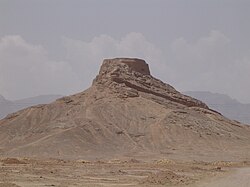Zartosht 30salegee
Autor:
Photo is extracted from "Persia by a Persian: being personal experiences, manners, customs, habits, religious and social life in Persia". Author: Isaac Adams. Published by: E. Stock, 1906.
Formát:
600 x 1112 Pixel (271526 Bytes)
Popis:
19th century
Indian-Zoroastrian perception of
Zoroaster derived from a figure that appears in a 4rd century sculpture at
Taq-e Bostan in south-western Iran.
The original 4th century high-relief scene depicts the investiture of
Ardeshir II, with the figure later perceived to be Zoroaster standing to the left of the king.
In both the original and the 19th century interpretation, the figure bears a
barsom in hand. This ritual implement, consisting of a (usually unbound) bundle of rods or sticks, is used even today to solemnize Zoroastrian religious ceremonies. In the reinterpretation, the figure wears the ceremonial headgear of a
Zoroastrian high priest.
In the academic literature of 19th- and early 20th century, the figure in the carving was indeed assumed to be an depiction of Zoroaster. That assumption is no longer followed today (it is generally assumed to be the
yazata of "binding oath", guaranteeing/blessing the investiture).
Like most other 19th century Indian Zoroastrian images of Zoroaster, the facial features depicted in the reinterpretation are strongly influenced by western depictions of Jesus. Together with other Indian Zoroastrian religious art (to some extent also beliefs and practices), this image began appearing among the Zoroastrians of Iran some time after 1855.
For a review of this and other "Zoroaster" imagery, see: Stausberg, Michael (2002),
Die Religion Zarathushtras, Vol. I, Stuttgart: Kohlhammer, pp. 58-59. The book includes a CD with a high-res color version of this portrait.
Komentář k Licence:
Tento obrázek nemusí být volným dílem mimo Spojené státy; to se týká zvláště těch zemí a oblastí, kde pro americká díla neplatí
pravidlo kratší doby, jako jsou Kanada, Kontinentální Čína (ne Hong Kong nebo Macao), Německo, Mexiko a Švýcarsko. Tvůrce a rok publikace jsou nezbytné informace a musí být uvedeny. Viz
Wikipedie:Autorské právo pro více informací.
Credit:
NY Public Library
Více informací o licenci na obrázek naleznete zde. Poslední aktualizace: Mon, 10 Mar 2025 10:26:14 GMT
Relevantní obrázky
Relevantní články
Zarathuštra
Zarathuštra, též Zoroaster, persky Zardušt, byl starověký íránský náboženský vůdce, zakladatel zarathuštrismu, autor gáthů, nejstarší části Avesty.
.. pokračovat ve čtení
Zoroastrismus
Zoroastrismus nebo zarathuštrismus, také mazdaismus, je íránské (perské) dualistické náboženství založené podle tradičního podání prorokem Zarathuštrou. Termín pársismus, odvozený od Pársů neboli „Peršanů“, se vztahuje primárně na zoroastriány žijící v Indii. Vyznavači tohoto světového náboženství uctívají Ahura Mazdu, a jemu podřízená božstva jako jsou Ameša Spentové a jazatové, kteří následují Ašu „Pravdivost“ a stojí v opozici vůči Angra Mainjuovi a jeho démonických služebníkům daévům, kteří následují Drudž „Klamství“. Významné místo zaujímá také kult ohně. Ústředním náboženským textem je Avesta, kromě toho existuje velké množství náboženské literatury z doby Sasánovské říše psané středopersky, jako Dénkart nebo Bundahišn, a taktéž pozdější díla. Přestože je od 7. století počet jeho vyznavačů velice nízký, je pravděpodobné, že mělo vliv na velká monoteistická náboženství: judaismus, křesťanství a islám. Ze zoroastrismu také vychází zaniklá náboženství manicheismu a mazdakismu.
.. pokračovat ve čtení














